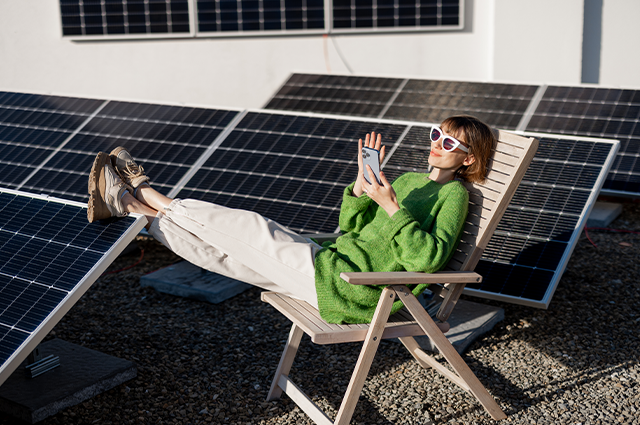Nowadays, sustainability and energy efficiency are no longer a luxury; they have become decisive criteria for business success. Cost pressure, market volatility, and the growing expectations of customers and investors make solar energy an obvious choice: it is profitable, it is environmentally friendly, and it has a direct impact on competitiveness. By turning sunlight into clean electricity, companies can significantly reduce operating costs, stabilise expenses over the long term, and access tax benefits that make the investment more affordable. Put simply, investing in solar energy opens the door to a lower electricity bill and a set of incentives that maximise returns, while strengthening your environmental responsibility credentials.
Cost reduction begins the moment a company starts generating its own electricity. By adopting photovoltaic systems for self-consumption, dependence on the traditional grid decreases and, with it, the impact of constant tariff fluctuations. Every kilowatt-hour generated in-house is a kilowatt-hour that does not need to be purchased, translating into immediate, measurable savings on the bill. After the initial investment, the system runs continuously with minimal intervention. Modern panels require very little maintenance and, under normal conditions, have a service life that exceeds twenty-five years. This means predictable costs, few interruptions, and a lifecycle that spreads the investment over many years.
There is also an additional effect many overlook: when generation exceeds consumption, the surplus can be fed into the grid. Instead of wasting energy during the hours of highest irradiation, the company turns that excess into a source of revenue, improving the P&L and shortening the project’s payback period. In parallel, the company is naturally protected against unexpected tariff hikes. By producing a large share of the energy it consumes, exposure to electricity price swings falls and cost predictability rises—gold for financial management. The sum of these factors shows up in the metric management cares about most: consistent savings on the bill and CAPEX that pays for itself.
In Portugal, the energy transition has been encouraged by concrete measures that enhance the viability of photovoltaic projects. There are corporate income tax (IRC) benefits for investments in renewable energy that help reduce companies’ tax burdens. The Recovery and Resilience Plan includes targeted support for efficiency and clean-generation projects, combining grants and non-repayable funding, thereby lowering the net investment. In certain cases, solar equipment may benefit from reduced VAT rates, contributing to a more competitive final price. Some municipalities add local incentives to accelerate photovoltaic installations across their business communities, while banks and other institutions offer credit lines designed for energy-transition projects on terms more attractive than generic financing.
Viewed through the financial lens, the investment case is clear. Average payback typically ranges from four to seven years, depending on the consumption profile, system size, tariffs paid, the incentive structure actually applied, and the ability to monetise surplus energy fed into the grid. A serious appraisal must factor in installed capacity, the company’s hourly load curve, contracted energy prices, the fiscal framework, and available support schemes. With a solid feasibility study, it is possible to tune the system to match production with need, maximise self-consumption, cut waste, and shorten the payback period. From the moment the investment has paid for itself, the electricity generated becomes direct savings, year after year.
Implementing solar properly starts with understanding your energy profile. It is essential to analyse invoices, peak hours, seasonality, and potential opportunities to shift loads. Based on these data, you define the ideal capacity of the photovoltaic system, avoiding costly oversizing or timid solutions that leave value on the table. Technology choices should consider the right combination of panels, inverters, and, where appropriate, battery storage to increase the self-consumption rate and provide resilience for critical operations. Then comes the financial chapter: compare quotes, structure the investment with the available incentives, and, if necessary, use dedicated financing that preserves cash flow without sacrificing returns.
Installation should be entrusted to a certified installer capable of ensuring technical compliance, safety, and the documentation required to access support schemes. Real-time monitoring is another non-negotiable: it allows you to measure performance, detect anomalies, optimise settings, and verify savings. In parallel, the tax component cannot be improvised. It is worth involving an accountant or specialist to ensure the correct application of deductions, asset eligibility, and all formal requirements, so that every expected benefit actually lands in the company’s results.
At the end of the day, the conclusion is straightforward. Solar energy is a strategic decision to cut operating costs, stabilise expenses, and adopt sustainable practices without giving up profitability. Bill savings, combined with tax incentives and government support, make the investment more attractive and less risky. With planning, data, and competent execution, the company lowers its overheads, increases predictability, and actively contributes to a lower-emissions future.
There is also a gain that does not fit neatly into spreadsheets: reinforcing sustainability as part of your value proposition. Adopting solar positions the company as responsible, innovative, and aligned with market and societal expectations. Customers, talent, and partners value organisations that do more than talk about sustainability. Generating your own clean energy is one of those actions that is visible, measurable, and translates into real competitive advantage.






